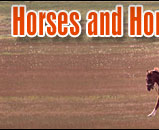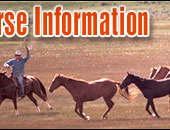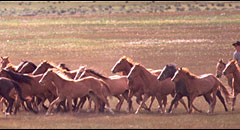 |
   |
|
|
|
You are here: Horses > Horse training > A bit of advice |
|
How Horse Bits Work and Basic Rider Uses
Your horse's mouth is extremely sensitive, with gums
between his front and back teeth the usual place of
influence for the bit. Called the bars, these "empty" spots
are alive with nerve endings, as well as the tongue, inner
checks, lips and palate. Choosing the right bit for your
horse is important: using it correctly is imperative. |
|
|
But there are many kinds bits
out there and as many opinions and definitions about which are the right
type to use. One thing that experts agree on; most novices assume
that, to work with a big animal, one needs a strong bit.
It's not true, actually. Aside from causing pain and
fractiousness in the horse, the wrong size of bit or a bit
wrongly placed can cause mouth damage that will not only
lessen communication during riding but will affect the
health and happiness of your horse. |
Bits work by exerting pressure inside the horse's mouth. The
are often assisted by bridle types that create additional
pressure around the horse's head—cheeks, chin or nose. The
idea is that, by moving away from the discomfort of the
pressing bit, the horse moves in the direction the rider
wants to go. In a properly trained horse with the right tack
and a knowledgeable rider, it all works together to create
unity between the rider's wishes and the horse's
performance.
 The
bit goes inside the horse's mouth, where it presses on the
tongue and applies pressure to the bars in the mouth. The
bars are made of sensitive cartilage, and easily feel the
movement of the bit as it responds to the reins. Some bits
put pressure on the lips, which doesn't work well because
the lips move and because their sensitivity makes them
easily damaged. Bits may also press against the roof of the
mouth. The
bit goes inside the horse's mouth, where it presses on the
tongue and applies pressure to the bars in the mouth. The
bars are made of sensitive cartilage, and easily feel the
movement of the bit as it responds to the reins. Some bits
put pressure on the lips, which doesn't work well because
the lips move and because their sensitivity makes them
easily damaged. Bits may also press against the roof of the
mouth.
When purchasing a bit, consider its width. The mouthpiece of
a bit shouldn't be too thin; it creates too much pressure on
the bars. A wider mouthpiece covers a larger contact area
and diminished the pressure. It's like the difference
between pressing a cheese slicer against your thumb or
pressing a butter knife: the cheese slicer will put more
pressure in a smaller area, creating more pain. (And if you
want something closer to what your horse may be feeling with
a thin bit, try the cheese slicer on your tongue). You can
also imagine the pressure difference by thinking about
shoes. Women's high heels, with small contact area, can poke
a deep hole in a golf green. Sneakers, with the contact area
spread over several inches, will just mash the grass a
little.
Next, consider shape. A straight bit puts more pressure on
the horse's tongue and less on the bars. Some bits are
curved, with grooves or hinges, which go easier on the
tongue but increase pressure on the bars.
Also important is the leverage of the bit. A curb bit, for
example, usually has a pressure ratio of three to one: if
you put five pounds of pressure on the reins, your horse
will feel 15 pounds of pressure in his mouth. Curb bits
aren't used for providing directional signals, but for
braking. Instead of putting pressure on one side or the
other, the curb bit puts pressure between the chin and the
bars.
The most important thing about bits is knowing what not to
use them for. The bit is only part of a larger scenario:
riders should be using their seat and legs to direct the
horse, and the information from the bit shouldn’t outweigh
the information from your body. People who rely on bits to
create the ride are often novices who don't understand
communication between horse and rider.
 |
Read the next horse training article on Horse Training Tips. |
|
|
|
|
 |
|
|
|
|
|
Horse Education
|
|
|
|
|
Horse Information Topics
|
|
|
|
|
|
|
|
Horse Business Owners
|
| |
Advertise with Us
Have your horse products or services exposed to over 27,000 of our monthly visitors.
|
|
|
|
|
|